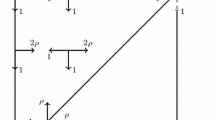Abstract
Consider a network where two routes are available for users wishing to travel from a source to a destination. On one route (which could be viewed as private transport) service slows as traffic increases. On the other (which could be viewed as public transport) the service frequency increases with demand. The Downs-Thomson paradox occurs when improvements in service produce an overall decline in performance as user equilibria adjust. Using the model proposed by Calvert [10], with a ⋅|M|1 queue corresponding to the private transport route, and a bulk-service infinite server queue modelling the public transport route, we give a complete analysis of this system in the setting of probabilistic routing. We obtain the user equilibria (which are not always unique), and determine their stability.
Similar content being viewed by others
References
J.E. Abraham and J.D. Hunt, Transit system management, equilibrium mode split and the Downs-Thomson paradox. Preprint. Department of Civil Engineering, University of Calgary.
E. Altman, T. Başar, T. Jiménez and N. Shimkin, Routing into two parallel links: Game-Theoretic Distributed Algorithms. Journal of Parallel and Distributed Computing 61 (2001) 1367–1381.
E. Altman, T. Boulogne, R. El Azouzi, T. Jimenez and L. Wynter, A survey on networking games in telecommunications. Computers and Operations Research, in press.
E. Altman, R. El Azouzi and V Abramov, Non-cooperative routing in loss networks. Performance Evaluation 49 (2002) 257–272.
R. Arnott and K. Small, The economics of traffic congestion, American Scientist 82 (1994) 446–455.
N.G. Bean, F.P. Kelly and P.G. Taylor, Braess’s paradox in a loss network. J. Appl. Prob. 34 (1997) 155–159.
C.E. Bell and S. Stidham Jr., Individual versus social optimization in the allocation of customers to alternative servers, Management Sci. 29 (1983) 831–839.
D. Braess, Uber ein Paradox der Verkehrsplanung, Unternehmensforschung 12 (1968) 258–268.
D. Braess and G. Koch, On the existence of equilibria in asymmetrical multiclass-user transportation networks, Transportation Science 13 (1979) 56–63.
B. Calvert, The Downs-Thomson effect in a Markov process, Probability in the Engineering and Informational Sciences 11 (1997) 327–340.
B. Calvert, W. Solomon and I. Ziedins, Braess’s paradox in a queueing network with state-dependent routing, J. Appl. Prob. 34 (1997) 134–154.
J.E. Cohen and F.P. Kelly, A paradox of congestion in a queueing network. J. Appl. Prob. 27 (1990) 730–734.
A. Downs, The law of peak-hour expressway congestion, Traffic Quarterly 16 (1962) 393–409.
R. Hassin and M. Haviv, To Queue or Not to Queue: Equilibrium Behavior in Queueing Systems (Kluwer, 2003).
J.L. Horowitz, The stability of stochastic equilibrium in a two-link transportation network, Transportation Research-B 18B (1984) 13–28.
F.P. Kelly, Network routing, Phil. Trans. R. Soc. Lond. A. 337 (1991) 343–367.
J. Maynard Smith, Evolution and the Theory of Games (Cambridge, University Press, 1982).
M.J.H. Mogridge, Planning for optimum urban efficiency; the relationship between congestion on the roads and public transport, Transportation Planning Systems (1990) 11–19.
A. Orda, R. Rom and H. Shimkin, Competitive routing in multiuser communication networks, IEEE/ACM Transactions on Networking 1 (1993) 510–521.
M Patriksson, The Traffic Assignment Problem: Models and Methods (VSP, 1994).
W.H. Sandholm, Potential games with continuous player sets, Journal of Economic Theory 97 (2001) 81–108.
M.J. Smith, The existence, uniqueness and stability of traffic equilibria, Transportation Research 13B (1979) 295–304.
M.J. Smith, The stability of a dynamic model of traffic assignment—an application of a method of Lyapunov, Transportation Science 18 (1984) 245–252.
J.M. Thomson, Great Cities and Their Traffic (Gollancz, Peregrine Edition, London, 1977).
J.G. Wardrop, Some theoretical aspects of road traffic research, Proceedings, Institution of Civil Engineers, II 1 (1952) 325–378.
D. Watling, Asymmetric problems and stochastic process models of traffic assignment, Transportation Research–B 30 (1996) 339–357.
W. Whitt, Deciding which queue to join: Some counterexamples, Operations Research 34 (1986) 55–62.
Author information
Authors and Affiliations
Corresponding author
Additional information
AMS subject classification: 60K30, 90B15, 90B20, 91A10, 91A13
Rights and permissions
About this article
Cite this article
Afimeimounga, H., Solomon, W. & Ziedins, I. The Downs-Thomson Paradox: Existence, Uniqueness and Stability of User Equilibria. Queueing Syst 49, 321–334 (2005). https://doi.org/10.1007/s11134-005-6970-0
Received:
Revised:
Issue Date:
DOI: https://doi.org/10.1007/s11134-005-6970-0




